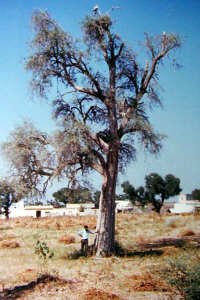Harsawa
Thank you for being part of the Bharatpedia family! 0% transparency: ₹0 raised out of ₹100,000 (0 supporter) |
Harsawa | |
|---|---|
Village | |
 Tecomella undulata tree in Harsawa village | |
| Coordinates: 27°54′N 74°58′E / 27.9°N 74.97°ECoordinates: 27°54′N 74°58′E / 27.9°N 74.97°E | |
| Country | |
| State | Rajasthan |
| District | Sikar |
| Elevation | 332 m (1,089 ft) |
| Population (2001) | |
| • Total | 1,695 |
| Languages | |
| • Official | Hindi |
| Time zone | UTC+5:30 (IST) |
| PIN | 332301 |
| Telephone code | 01571 |
| Vehicle registration | RJ-23 |
Harsawa is a village located in the Sikar district of Shekhawati region, in Rajasthan state, India. Harsawa is within the Fatehpur Tehsil, 8 km south along National Highway-11 from Fatehpur town. Sand dunes of the Thar Desert can be seen from Harsawa. As of 2001[update], the village had a total population of 1695.
History[edit]
After the defeat of the last Hindu King of Delhi, Prithviraj Chauhan, in the second Battle of Tarain (1192), the Jats in his army moved to the countryside and settled as cultivators at various places in India. Initially Saharan gotra Jats came to this area and started temporary cultivation, but after some time they left. Subsequently, Nehra gotra Jats from the nearby village of Banthod migrated to this place and started cultivation. One of these Nehra gotra Jats was Harsa Nehra, who founded the village of Harsawa in 1287 AD. Later settlers included Dhaka gotra Jats from Juliasar and Datujala villages, Thori gotra Jats from Ramsisar, Bhaskar gotra Jats from Rajas, Lamoria gotra Jats from Antroli and Dhayal gotra Jats from Fuskani villages.
Geography[edit]
Harsawa is located at 27°55' North, 74°59' East. The total geographical area of the village is 4000 bigha (1,600 acres or 650 hectares). National Highway-11, from Bikaner to Jaipur, passes through Harsawa, as does the railway line from Bikaner to Jaipur. Harsawa is near to the historical village of Garinda.
The natural climatic conditions in the village are very harsh and extreme. Temperatures range from below 0 °C (32 °F) in winter to over 50 °C (122 °F) in summer. The summers bring hot waves of air called "loo". The village lies in the Thar Desert region, and annual rainfall is very low, on the scale of 450 millimetres (18 in). The ground water in the village is hard and salty and as deep as 200 feet (61 m). The people in the region depend on rainwater for agriculture. Rainwater is also stored in pucca tanks for drinking purposes. On average the region faces a dry year every third year, and a famine year every eighth year. During famine years it becomes very difficult for the animals to survive, for want of fodder, and the cattle population goes down drastically.
Demographics[edit]
As of the census of 2001, the population was 1695, of whom 829 were male and 866 were female. Literacy in the village is at 81.17%. All the villagers belong to the Hindu religion, and about ninety percent are of the Jat caste. castes include Rajputs, Brahmans, Swami, Harijans, Naik and Jangir. There is one temple of Hanumanji, one temple of the Goddess Mawali and one than (a sacred place) of Gogaji.
Economy[edit]
The main occupation of the villagers is agriculture. There are 140 persons serving the Indian Army, central and state governments. About 110 people have gone to Arab countries to work; three families of Dhadhi caste are engaged in music and have gone to Pakistan. A large number of villagers work in the Agricultural Research Station, Fatehpur, and the Central Sheep Breeding Farm, Fatehpur, which are located just adjoining the village.
Education[edit]
Harsawa is considered to be a progressive village for the region. Education in the village was started in 1934 with the cooperation of villagers. Hardev Singh Nehra started formal education in 1935 with the help of Birlas under the "Vernacular" scheme. The first primary school was instituted by the state government in 1949, and it has now been upgraded to encompass a Sr.school. There is also a number of private schools. Social workers Chaudhary Bhagu Ram Bhaskar and Choudhary Gharsi Ram Nehra and Chunni Lal Nehra show the way of technical education in the village. Students are studying continuously for the development of their village.
Role in the abolition of Jagirs[edit]
Harsawa played an important role in the abolition of Jagirs. Before independence in 1947, the conditions of the farmers were very bad. The farmers were exploited and oppressed by the Jagirdars during the British Raj, and were deprived of fundamental rights. When the Jagirdars did not receive cesses, known as "lag" or "begar", in time, the farmers were given hard punishments and their crops were destroyed.
The farmers of Harsawa united against the oppression of the Jagirdars and stopped giving cesses. Chaudhari Motaram and Chaudhari Bhagu Ram Bhaskar 15 others of Harsawa village were arrested by Raja of Sikar in 1935 and imprisoned for three months. Farmers, mainly Jats, joined "Sikar Jat-Kisan-Panchayat" and "Jaipur Praja-Mandal", along with the Shekhawati farmers. After a long struggle the farmers got rid of oppression and acquired ownership rights over the land they had been cultivating. under the leadership of Chaudhari Hardev Singh nehara.
Notable persons from the village[edit]
- Choudhary Gharsi ram
Fhusaram ji dhaka
- H
- bhagirathmal nehra
- Dhaka family
- Jagdish nehra j.p

